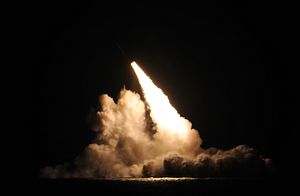An Ohio-class ballistic missile submarine (SSBN) assigned to the U.S. Navy’s Submarine Group 9 test launched a number of Trident II D5 ballistic missiles from submerged position in the Pacific Missile Range off the coast of California in February, the U.S. Navy announced in a press release.
The test launches were conducted over a three-day period from February 14 to 16 as part of a so-called Follow-on Commander’s Evaluation Test (FCET). “The primary objective of an FCET is to obtain, under operationally representative conditions, valid reliability, accuracy, and performance of the missile system for use by Commander, Strategic Command and the Joint Chiefs of Staff,” according to a U.S. Navy statement.
All four missile test flights were deemed successful. “The missiles were unarmed and all launches were conducted from the sea, flew over the sea, and landed in the sea. At no time did the missiles fly over land,” the statement reads. The Trident II D5 is a submarine-launched ballistic missile fitted with multiple independently targetable reentry vehicles and was first introduced into service in 1989. The missiles range is about 4,000 nautical miles (around 7,400 kilometers). Since its introduction to the fleet, the Trident II D5 missile has completed 165 successful test flights.
The Ohio-class is the sea leg of the United States’ strategic deterrent triad, and also the “the most survivable leg of the triad” providing “the national command authority with assured second-strike capability,” according to the U.S. Navy. The lead boat of the Ohio-class first entered service in 1981 with the last submarine of the class commissioned in 1997. The U.S. Navy is currently operating 14 Ohio-class SSBNs, capable of carrying up to 24 Trident II D-5 submarine-launched ballistic missiles.
Submarine Group 9 — based out of Naval Base Kitsap in Bangor, Washington and part of Submarine Force Pacific — consists of two guided missile submarines (SSGN) and two ballistic missile submarines. However, all four boats are Ohio-class submarines. As I reported elsewhere, from 2002 to 2008, the U.S. Navy transformed four of its oldest Ohio-class SSBNs into nuclear-powered guided missile subs. The four boats — the USS Ohio, USS Michigan, USS Florida and USS Georgia — will remain in service until the middle of the 2020s. Two of the U.S. Navy’s four Ohio-class SSGNs currently serve with Submarine Group 9.
As I explained previously, a new class of SSBNs, the Columbia-class, will begin replacing the Ohio-class in 2031. (Beginning in 2027, roughly one submarine per year will be decommissioned, with the last boat set to be retired in 2040.) The new subs, designed for a 42-year service life all the way through 2085, will be the largest U.S. submarine ever to be constructed. The U.S. Navy plans to induct ten to 12 new boats in the coming decades.
































